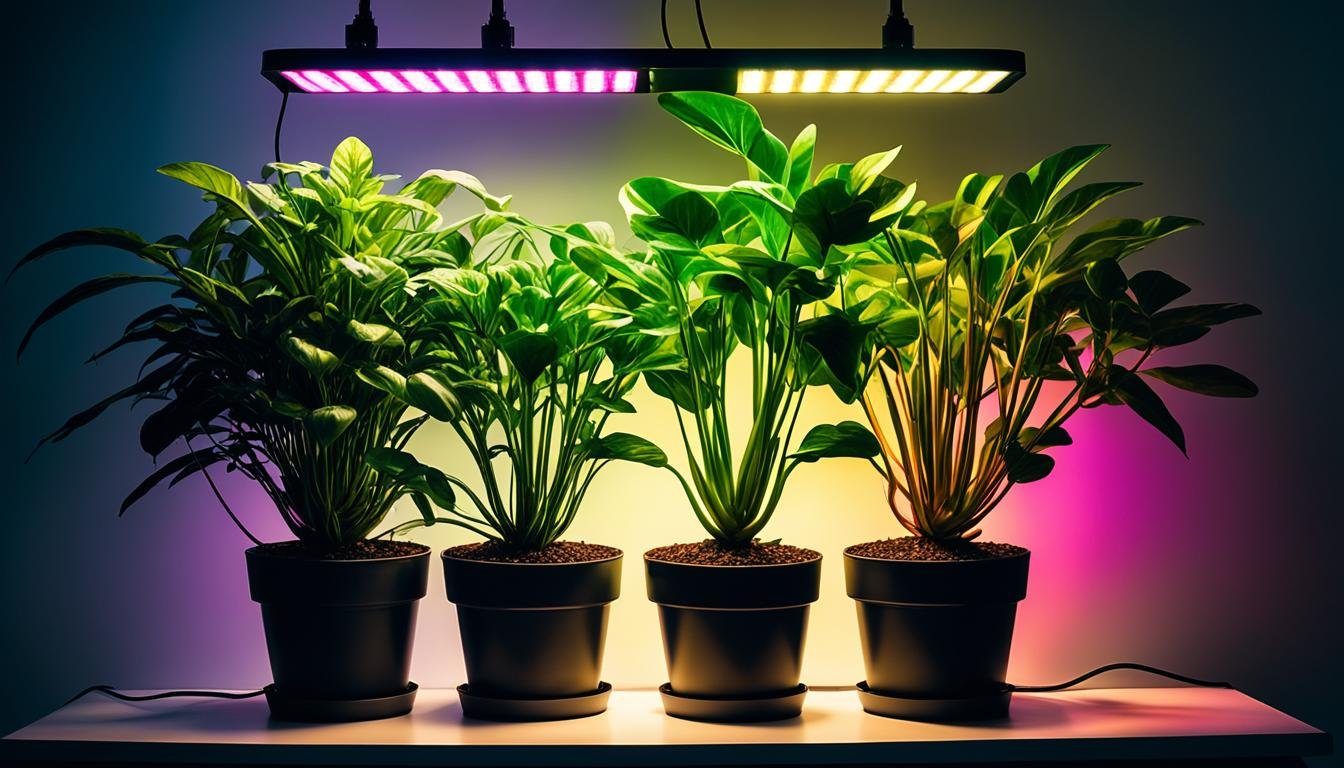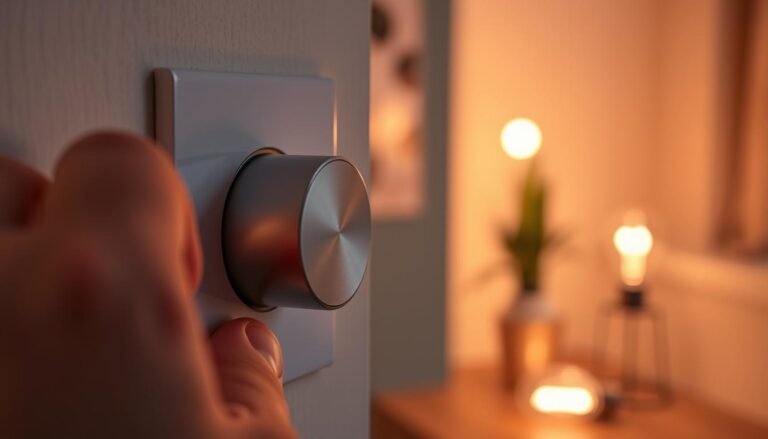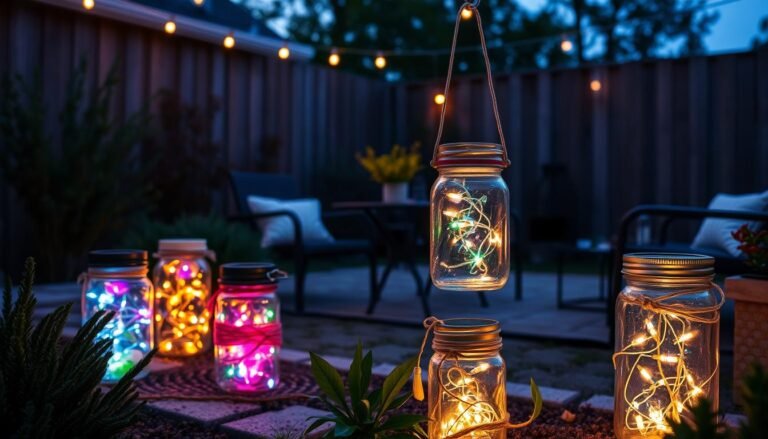Affiliate Disclosure: This post may contain affiliate links. If you make a purchase, we may earn a small commission at no extra cost to you.
Did you know indoor gardeners often struggle with insufficient sunlight? This makes it hard for plants to grow well. But, there’s a solution: plant grow lights! These lights are designed to give off the right type and amount of light. They help your plants be healthy and strong indoors.
Key Takeaways:
- Insufficient sunlight is a common challenge for indoor gardeners.
- Plant grow lights provide the perfect spectrum and intensity of light for healthy plant growth.
- Using grow lights can significantly boost the growth and vitality of your indoor greens.
- There are various types of plant grow lights available to suit different indoor gardening needs.
- Proper placement and timing of grow lights are key factors for maximizing their effectiveness.
Check out our FREE Calculators on our Resources Page
The Fundamentals of Indoor Grow Lights
If you’re into indoor gardening, you know how important grow lights are. They give off light that helps plants grow. So, why should you get indoor grow lights? We’ll dive into why they’re so popular.
Why Use Grow Lights?
Grow lights help when you can’t get enough natural light. Maybe you have little room or live where winters are long. They provide a consistent light source for plant growth.
You can adjust the intensity, type, and time of light with grow lights. This means you can make the perfect conditions for your plants. They also let you keep gardening all year, no matter the outside weather.
The Science of Grow Lights: Spectrum and Photosynthesis
Choosing the right grow light means looking at the light they give out. Plants need different light colors for photosynthesis. This is how they turn light into energy for growth.
Most grow lights have blue and red light. Blue light helps plants grow more green parts. This includes leaves and stems. Red light makes plants flower and fruit, leading to bright flowers and a good harvest.
Remember, each plant type likes different light colors. Picking the right grow lights lets you match the light to your plants. This helps them grow their best.
Comparing Grow Bulbs and Plant Grow Lights
In indoor gardening, you might think about using regular grow bulbs or special plant grow lights. They both provide light, but they have major differences.
Regular grow bulbs give off a wide range of light. But they might not have the best light for plant growth. Plant grow lights, however, are made just for indoor plants. They can offer the exact light plants need and use less energy.
Plant grow lights include options like fluorescent and LED lights. Fluorescent lights work well for starting seeds and for plants that like low light. LEDs are efficient, let you adjust the light, and met plants’ specific growth stage needs.
When picking between regular grow bulbs and plant grow lights, think about what your plants need. Also, consider how long and how well the lights will work.
Choosing the Right Plant Grow Lights
Selecting the right grow lights is key for indoor gardens. We’ll look at different types and their pros and cons.
Incandescent vs. Fluorescent vs. LED
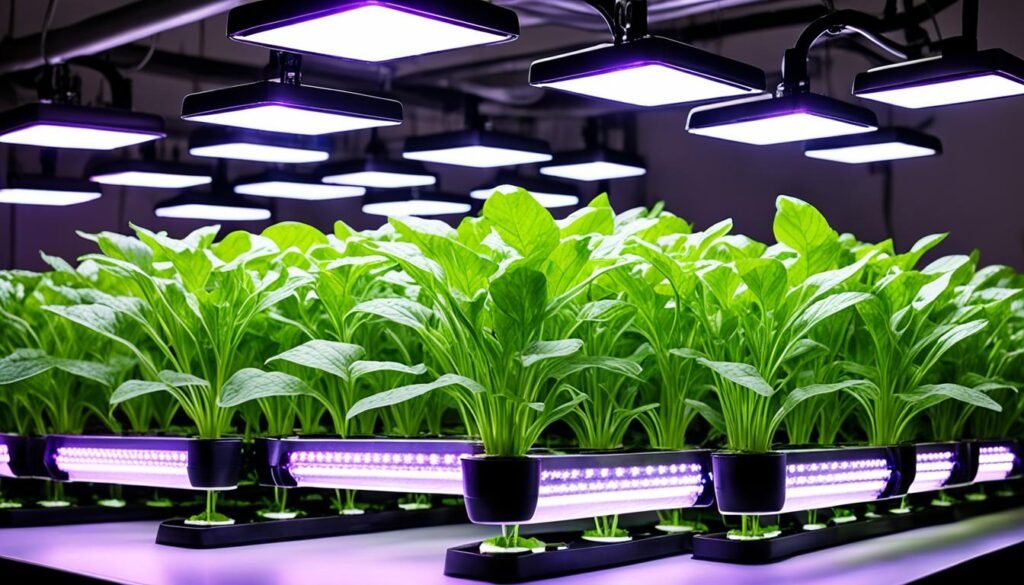
There are three main types of grow lights: incandescent, fluorescent, and LED. Each has unique benefits.
Incandescent lights are cheap but inefficient. They create too much heat, which can harm plants.
Fluorescent lights are energy-efficient and produce less heat. They come in various spectrums for different plant stages.
LED lights use the least energy and make little heat. They offer a wide range of spectrums for all plant growth stages.
Understanding Kelvin Temperature for Optimal Growth
It’s important to look at Kelvin temperature for grow lights. It impacts how plants grow.
Cooler light is best for growth stages, around 4000K to 6500K. This produces a bluer light for healthy leaves and stems.
Warmer light suits flowering and fruiting, from 2700K to 3000K. This redder light helps with flowers and fruits.
The Advantages of Full Spectrum Grow Lights
Full spectrum lights are great for indoor gardening. They mimic sunlight and have many plant benefits.
Full spectrum lights work like natural sunlight. They help plants grow healthily.
These lights cover all light spectrums, vital for all plant stages.
They support various plants, from greens to flowers.
They are good for plants that grow in water, not soil.
With this info, you’re set to pick the best grow lights for your plants.
Understanding light spectrum is key for good indoor plant growth. Blue and red lights are especially important. This guide will show you their roles. We’ll also cover why green and yellow light matter, and how to pick the best light for your plants.
The Importance of Blue and Red Wavelengths
Blue light, between 400-500 nanometers, boosts plant leaves and stems. It makes leaves and stems strong and healthy. Using enough blue light leads to lush, strong plants.
Red light, about 600-700 nanometers, is needed for flowers and fruit. It helps plants bloom and make fruits. Adding red light means a bigger, better harvest.
Does Green and Yellow Light Affect Plant Growth?
Green light, 500-600 nanometers, isn’t key for plant growth. Plants reflect most green light and don’t use it much. So, it doesn’t help much with making food or growing.
Yellow light, around 570-590 nanometers, also doesn’t do a lot for growth. But it might help some plant activities, like helping roots grow and take in nutrients.
Customizing Light for Seedlings and Fruiting Plants
Light needs change as plants grow. Seedlings do best with lots of blue light. Flowers and fruit need more red light. This helps them grow strong and bloom.
Finding the right light mix for your plants is important. Full spectrum lights are balanced for the whole plant life. They have everything, from blue to red, plants need.
Try different light mixes to see what works best for each plant. Watch your plants to pick the perfect light settings for them. Making small changes as you watch them grow can make a big difference.
Maximizing Growth: Proper Grow Light Placement and Use
Finding the right spot for grow lights is key for indoor plants to grow well. Place the lights the right way and know how strong they need to be. This makes your indoor plants really happy.
Optimal Placement Above or Around Your Plants
Giving all parts of your plants enough light is critical. Lights can go either above or around your plants.
If lights are above, make sure they’re high enough for even light. As plants grow, adjust to keep the perfect distance. This is good for tall plants or if you have a small space.
Placing lights around the plants spreads the light out more, like sunlight. This helps shorter plants or if you have lots of space to fill. It makes sure all sides of the plants get light, helping them grow evenly.
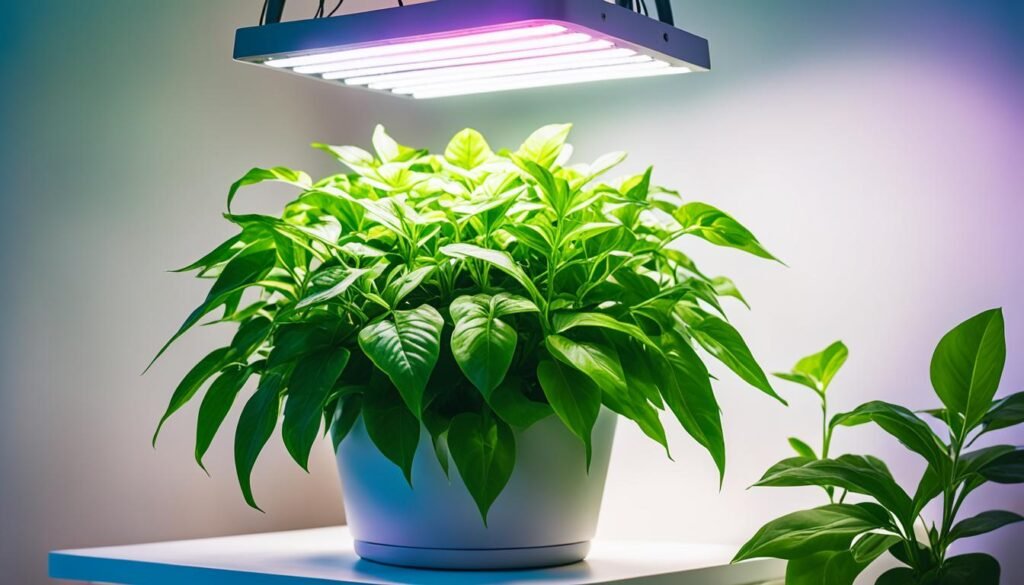
How Intensity and Brightness Impact Growth
How strong and bright your lights are matters a lot for plant growth. More intense light makes plants grow faster and compact. Less intense light can make them stretch and become weak.
Figuring out the best light strength depends on your plant’s needs. Each plant type likes a certain light level. Always check a plant care guide or ask an expert. Update the light as your plants grow to avoid damage.
Brightness affects growth and how good you feel around the plants. Adjust it to a level that’s nice for you and your plants. The right brightness makes plants happier and healthier.
Timing Your Grow Lights for Healthier Plants
When you turn the lights on and off is just as important. Plants need a break from light to grow well. A fixed light and dark schedule mimics the outdoors and helps plants stay healthy.
Plants need a certain number of hours of light each day. The time varies by plant. Some need up to 16 hours, others do well with 10-12. Don’t leave lights on all the time. It messes up the plants’ natural cycles and hurts growth.
Set your lights to match natural day and night cycles. For example, on in the morning, off at night. This keeps plants in rhythm with the outdoor world.
By carefully choosing where, how strong, how bright, and when to use your grow lights, your plants will do more than just survive. They’ll thrive.
Conclusion
Grow lights are great for your indoor plants. They help plants grow better and stay healthy. You can choose from different types such as LED grow lights. This means you can get the perfect light for your house plants.
Learning about indoor grow lights is key. By knowing how they help plants, you can pick what’s best. This is true for all plants, like seedlings, foliage, or flowers. The right grow light system boosts plant growth by making sure they get the light they need.
Full spectrum grow lights and hydroponic grow lights are available. This lets you pick the best light for your indoor garden. So why wait? Adding grow lights can turn your indoor garden into a beautiful, healthy paradise.
It’s not just any light – it’s about the right light. The kind that plants need at the perfect time. Exploring house plant grow lights is exciting. It helps you make the most of your indoor plants.
FAQ
Why should I use plant grow lights for indoor gardening?
How do plant grow lights substitute natural sunlight?
What types of plant grow lights are available?
Why should I use grow lights in indoor gardening?
What is the role of spectrum and photosynthesis in plant growth?
How do grow bulbs differ from plant grow lights?
How do I select the right type of grow lights for my plants?
What are the benefits and drawbacks of incandescent, fluorescent, and LED grow lights?
Why is Kelvin temperature important in selecting grow lights?
What are the advantages of using full spectrum grow lights?
How do blue and red wavelengths affect plant growth?
Does green and yellow light impact plant growth?
Can I customize the light spectrum for different stages of plant growth?
How should I place grow lights for optimal plant growth?
How do light intensity and brightness affect plant growth?
When is the best time to use grow lights for healthier plants?
What are the benefits of using plant grow lights for indoor gardening?
How can I start incorporating plant grow lights into my indoor gardening routine?
Source Links
- https://thegreenmadhouse.com/plants/beginners-guide-to-choosing-and-using-grow-lights
- https://foodiegardener.com/grow-lights-for-beginners-start-plants-indoors/
Check out our FREE Calculators on our Resources Page

